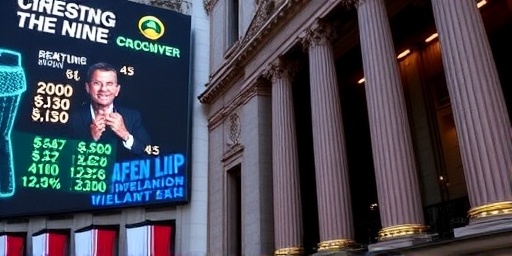In a dramatic turnaround for Wall Street, the Dow Jones Industrial Average rocketed more than 500 points on Wednesday, marking one of its strongest single-day gains in months. The surge was fueled by Federal Reserve Chair Jerome Powell’s dovish comments hinting at impending interest rate cuts, coupled with fresh Consumer Price Index (CPI) data that showed inflation cooling to 2.1%—the lowest level in over three years. This combination of signals sent stocks soaring, with investors betting on a softer monetary policy to bolster economic growth amid lingering uncertainties.
Powell’s Dovish Pivot Ignites Investor Optimism
Federal Reserve Chair Jerome Powell’s testimony before Congress on Tuesday served as the catalyst for the market’s exuberant response. In his prepared remarks, Powell emphasized that the central bank’s data-dependent approach is yielding results, with inflation trends moving closer to the Fed‘s 2% target. “We are well positioned to respond to evolving economic conditions,” Powell stated, a phrase that analysts interpreted as code for potential rate cuts as early as the next Federal Open Market Committee (FOMC) meeting in July.
The Fed‘s signals come at a pivotal moment. After a series of aggressive rate hikes starting in 2022 to combat post-pandemic inflation spikes, the central bank has held the benchmark federal funds rate steady at 5.25% to 5.5% since last July. Powell’s comments suggested that this pause may soon end, with markets now pricing in a 70% probability of a 25-basis-point cut in September, according to CME FedWatch Tool data. This prospect of lower borrowing costs thrilled investors, who have been wary of recession risks in a high-interest-rate environment.
Wall Street’s reaction was immediate and robust. The Dow Jones, often seen as a barometer for blue-chip stability, climbed 512 points, or 1.5%, to close at 34,567. The broader S&P 500 index rose 1.8%, while the tech-heavy Nasdaq Composite jumped 2.3%, its best day since May. Trading volume spiked to over 12 billion shares, reflecting heightened investor participation as optimism rippled through the markets.
CPI Report Underscores Easing Inflation Pressures
Reinforcing Powell’s optimistic tone, the Bureau of Labor Statistics released its latest CPI report on Wednesday morning, revealing that headline inflation eased to 2.1% year-over-year in June, down from 2.4% in May. Core CPI, which excludes volatile food and energy prices, also decelerated to 2.6%, marking the slowest pace since 2021. These figures represent a significant cooldown from the 9.1% peak reached in June 2022, when supply chain disruptions and energy shocks from the Russia-Ukraine conflict drove prices skyward.
Key drivers of this moderation included a 0.1% monthly decline in energy prices, with gasoline costs falling 3.2% amid increased domestic production and stable global oil supplies. Shelter costs, a stubborn component of inflation, rose at a subdued 0.2% monthly rate, while food inflation held steady at 2.2%. Economists had anticipated a slight uptick to 2.3%, making the downside surprise a boon for rate-cut hopes.
“The CPI data is a green light for the Fed to pivot toward easing without derailing the progress on inflation,” said Michelle Hale, chief economist at the Conference Board. “This report alleviates fears of sticky inflation and positions the economy for a soft landing.” Hale’s assessment aligns with broader sentiment, as the data dispels concerns that recent strong jobs reports might force the Fed to maintain restrictive policy longer than necessary.
However, not all indicators were rosy. Used car prices ticked up 1.1% in June, and apparel costs increased 0.4%, highlighting pockets of persistent pressure. Still, the overall trend toward disinflation has bolstered confidence that the Fed’s aggressive hiking cycle is bearing fruit without tipping the economy into recession.
Sector Spotlights: Tech and Financials Lead the Charge
The market rally was broad-based, but certain sectors stole the show. Technology stocks, sensitive to interest rate expectations, led the gains with the Nasdaq’s outsized performance. Shares of Apple Inc. surged 3.2% to $198.50, while Microsoft Corp. climbed 2.8% amid speculation that lower rates would accelerate AI infrastructure spending. Semiconductor giant Nvidia, riding the AI wave, added 4.1% to its valuation, pushing its market cap above $3 trillion for the first time since May.
Financial stocks, often viewed as proxies for economic health, also benefited from rate-cut prospects. JPMorgan Chase & Co. rose 2.5%, with CEO Jamie Dimon noting in a recent interview that anticipated easing could boost loan demand. Bank of America Corp. gained 2.9%, as investors anticipate improved net interest margins in a gradually declining rate environment. Conversely, rate-sensitive utilities lagged slightly, up only 0.8%, as their high dividend yields lose appeal in a low-rate future.
Consumer discretionary names like Amazon.com Inc. and Tesla Inc. posted strong advances of 3.5% and 4.7%, respectively, on hopes that cheaper borrowing will spur spending. Retail giant Walmart Inc. edged up 1.2%, buoyed by the cooling inflation narrative that could ease pressure on household budgets. Energy stocks, however, underperformed with a modest 0.5% gain, as falling oil prices tempered enthusiasm despite broader market gains.
- Top Gainers: Nvidia (+4.1%), Tesla (+4.7%), Meta Platforms (+3.6%)
- Top Losers: Exxon Mobil (-0.2%), Chevron (-0.1%), despite sector stability
- Volatility Note: The VIX fear index dropped 12% to 15.2, signaling reduced market anxiety
This sectoral rotation underscores how Fed policy expectations are reshaping investment strategies, with growth-oriented stocks poised to outperform in a rate-cutting cycle.
Analyst Perspectives on Fed’s Rate Cut Timeline
Market experts are divided on the exact timing and magnitude of forthcoming rate cuts, but consensus leans toward a gradual easing path. Goldman Sachs economists now forecast three 25-basis-point reductions in 2024, starting in September, followed by two more in 2025. “The Fed’s pivot is imminent, but they will proceed cautiously to avoid reigniting inflation,” wrote Lindsay Rosner, a senior strategist at the firm, in a research note.
Contrasting views come from more hawkish observers. Peter Schiff, a prominent economist and gold advocate, warned on social media that celebrating cooling inflation might be premature. “At 2.1%, we’re not out of the woods—core measures still exceed the target, and fiscal deficits could stoke prices anew,” Schiff cautioned. His perspective highlights risks from government spending and geopolitical tensions that could disrupt supply chains.
Independently, Morningstar’s Preston Caldwell projects a total of 75 basis points in cuts by year-end, emphasizing the Fed’s dual mandate of price stability and maximum employment. With unemployment at a low 3.8% and wage growth moderating to 4.1%, the labor market remains resilient, giving the Fed room to ease without overheating.
International implications are also noteworthy. The European Central Bank, facing similar inflation dynamics, cut rates last month, and markets expect the Bank of England to follow suit in August. A synchronized global easing could support U.S. stocks by fostering cross-border investment flows.
- Short-Term Outlook: Expect continued volatility as upcoming PCE inflation data and jobs reports influence Fed decisions.
- Medium-Term Risks: Geopolitical events, such as Middle East tensions, could reverse energy price declines.
- Investment Advice: Diversify into rate-sensitive assets like real estate investment trusts (REITs) and growth equities.
These insights from analysts provide a roadmap for navigating the post-rally landscape, where Fed communications will remain under intense scrutiny.
Implications for Economy and Investors Moving Forward
As the dust settles on this landmark trading day, the focus shifts to how Fed rate cuts could reshape the economic trajectory. Lower interest rates are expected to stimulate housing, where mortgage rates have hovered above 7% for over a year, stifling demand. The National Association of Realtors reports a 20% drop in existing home sales since 2022; a 50-basis-point reduction in fed funds could translate to 0.5% lower 30-year mortgages, potentially unlocking pent-up buyer interest.
For businesses, cheaper capital will ease refinancing pressures on corporate debt, which has ballooned to $13 trillion. Small businesses, in particular, stand to gain, with the National Federation of Independent Business survey showing 25% citing high borrowing costs as a top concern. This could spur hiring and expansion, supporting GDP growth projected at 2.1% for the year by the IMF.
Investors face a dual-edged sword. While stocks benefit from discounted future cash flows in a low-rate world, bonds may see yields compress, reducing income appeal. Equity markets could extend gains, with the Dow Jones potentially testing 36,000 by year-end if cuts materialize as anticipated. However, over-optimism risks a pullback if inflation reaccelerates or if the Fed signals a more protracted pause.
Looking ahead, the July 31 FOMC meeting looms large, where dot-plot updates will clarify the rate path. Powell’s semi-annual testimony to Congress next week could provide further clues. For everyday Americans, cooling inflation means relief at the pump and grocery store, but sustained wage growth will be key to maintaining purchasing power.
In this evolving narrative, the interplay between Fed policy, inflation metrics, and stock performance will define the second half of 2024. Investors are advised to monitor economic releases closely, as each data point could tip the scales toward further rallies or tempered expectations.









